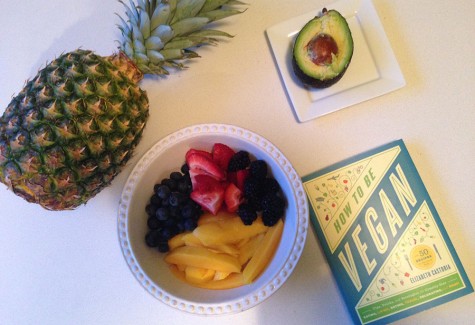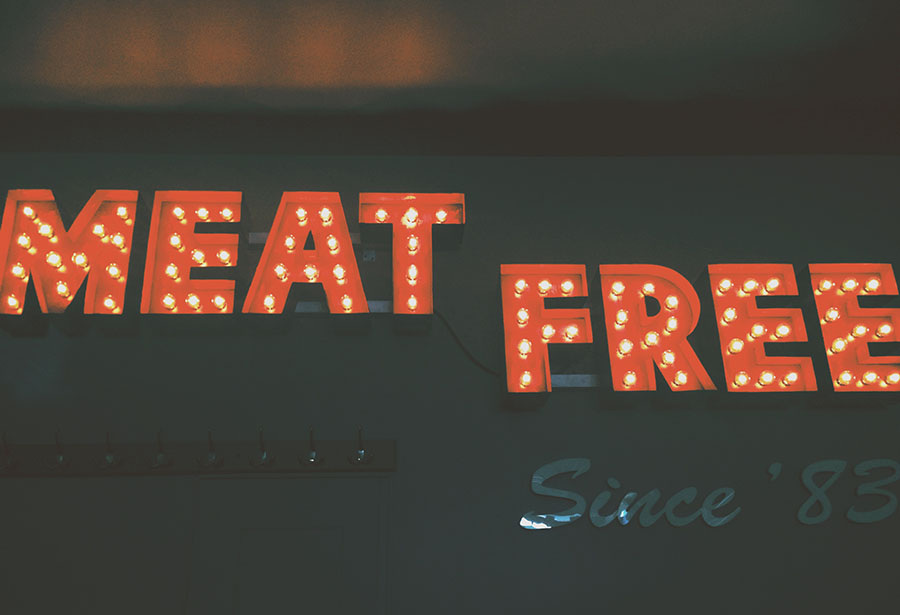Why veganism enriches my life
April 23, 2015
This is not my vegan manifesto.
I grew up eating meat. My dad, brother, friends, relatives and many of my peers are non-vegans. Over 95 percent of Americans eat meat.
By writing this, my intent is not to persuade readers that veganism is better, healthier or more effective than their current lifestyle, but rather to share my experience and shed light on facts and statistics that many aren’t aware of.
What we eat depends heavily on our environment, dietary needs, schedules and a number of other factors. Before I changed my eating habits, I was depriving myself of the nutrients I needed. Instead, I filled my body with unhealthy fats and processed sugars. As a person who functions best under strict limitations, a plant-based diet works for me. This isn’t the case for everyone. I hope that through writing this, I am able to demonstrate why veganism is suitable for me.
I remember the last time I bashfully rolled down my car window- for the third time in five days- to grab a neatly folded white baggie. “Enjoy your meal, miss,” the employee chirped ebulliently, as if she was handing me the riches of Solomon instead of blended chicken guts and three days worth of sodium.
Before that day, I had always been the type of girl to order my waffles “à la mode” and lose count of how many Pringles I had eaten. I had always been the one to scoff at my friends when they decided to eat fruit instead of Chips Ahoy. And until that point, I had been fine. But one day, I sat at my kitchen table, feeling unusually lethargic as I dipped chicken McNuggets into spicy buffalo sauce, and something felt different. Something had to change.
About a week later, my friends and I sat down in the corner booth at Colonial Cafe. Nervously scanning the menu, I tried to imagine the looks that would appear on their faces in a few short moments. I held my breath as our waiter approached us. When he looked at me, I stammered, “Uh… I’ll have a garden salad, with no cheese please. Also, a coffee. Do you have almond milk?” The waiter nodded as my friends exchanged baffled glances. Little did they know that they had just witnessed the inauguration of a year of happiness, health and change.
As I write this, I am trying to find a way to turn the words “I am vegan” into something that will be received as less pretentious. We live in the Midwest, the meat capital of the country. To the common eye, plant-based diets seem to be an effort at glamour, a sacrifice of juicy, delicious, 4 ounces pleasure topped with bacon for celery and tears; as if no one could actually enjoy a vegan lifestyle.
The result of this vegan stigma is a whole lot of weird looks as I pull out my tupperware container of tofu and brown rice at lunchtime, confusion when I ask for no butter in my pasta at Italian restaurants and questions when I politely decline a cookie or hand full of goldfish. Whenever asked, “Why are you vegan?” I usually answer by saying that eating a plant-based diet makes me feel best, a generic answer that, to my fault, probably still leaves people puzzled. This is my effort to define exactly what is that makes me feel best, and exactly why I decided to switch to a vegan diet during June of last year.
Veganism is a lifestyle in which no animals or animal products are consumed: no meat, no dairy, no eggs and any food that contains these. A large part of my choice to be vegan are the health benefits: no cholesterol, a reduced risk of cancer, more energy, healthier skin, longer life and lower blood pressure, to name a few.
 At family parties, my concerned relatives couldn’t seem to believe that veganism could be beneficial to my health, “No animal products, sweetie?!? Now where are you getting all of your nutrients from? What about protein?” In reality, I’m getting more nutrients in more plentiful amounts than I ever did before. Instead of snacking on a Snickers bar, with 27 grams of processed sugar and less than two percent of my daily Vitamin C, I snack on a mango, which is a great source of vitamin A and contains more than 200% of my daily Vitamin C. As for protein, most meat-consuming Americans eat twice as much protein as their body needs per day. The proteins I eat: nuts, legumes, beans and tofu are considered to be some of the healthiest forms of protein, as they are less dense and contain no cholesterol.
At family parties, my concerned relatives couldn’t seem to believe that veganism could be beneficial to my health, “No animal products, sweetie?!? Now where are you getting all of your nutrients from? What about protein?” In reality, I’m getting more nutrients in more plentiful amounts than I ever did before. Instead of snacking on a Snickers bar, with 27 grams of processed sugar and less than two percent of my daily Vitamin C, I snack on a mango, which is a great source of vitamin A and contains more than 200% of my daily Vitamin C. As for protein, most meat-consuming Americans eat twice as much protein as their body needs per day. The proteins I eat: nuts, legumes, beans and tofu are considered to be some of the healthiest forms of protein, as they are less dense and contain no cholesterol.
In the United States, according to the Centers for Disease Control and Prevention, the leading cause of death is heart disease. Consuming no cholesterol lowers blood pressure and promotes a healthier heart, greatly reducing the risk of heart disease. Not only do these facts exist on paper, but I feel them. I rarely get sick. I never feel sluggish after eating. I feel lighter, more energized and most importantly, happier.
In a country with increasing danger of water shortages, many aren’t aware of the enormous water footprint left behind by the livestock industry. According to an article on foodtank.com,to produce one pound of beef – enough to make only four McDonald’s quarter pounders- takes 1,800 gallons of water: about 36 bathtubs worth. Cultivating plants, like soybeans and corn, is significantly more resourceful, using only 100-200 gallons per pound. Even more shockingly, a vegan diet only uses 300 gallons of water to produce per day, while a meat-eating diet uses 4,000, according to an infographic on the mindfulworld.org. Water is an extremely precious resource, and not being conscious enough of our water usage could be detrimental to the future. Many would say that as one person, the amount of water I’m saving is insignificant (which, for reference, is 1,350,000 gallons per year). In retrospect, choosing a vegan diet allows me to do more to help the environment and less to harm it. Veganism allows me to give back to the world. Small steps are the only way to accomplish anything big, and by doing what I feel is my part, I am saving more than one million gallons of water each year.
I also object to animal cruelty within the meat industry. Next time you order ribs, think about the pig you are eating. Pregnant pigs are forced into gestation crates, measuring about 6.6 ft x 2 ft. In these crates, the pigs have little to no room to lay down, turn around or move. And whenever you’re at the grocery store buying eggs and you pick the ones labeled “cage free,” I’m sure you picture a family of happy chickens frolicking in an open field. In reality, hundreds of chickens are confined into a small, “free range” space instead of hundreds of chickens being confined into small cages. A basic level of humanity and sufficient living conditions should be granted to animals. Being vegan doesn’t stop these actions, but it makes me one less consumer.
Above all, I eat a plant-based diet for myself. Veganism is a challenge, but it’s one I enjoy. I like finding new recipes, taking the time to slice fruit and having to work within boundaries. When I was little, my mom always told me that you are what you eat. For a while, I guess I was a high sodium, deep-fried jumble of chicken parts. But now, I’m a garden. I wouldn’t have it any other way.
